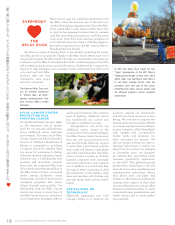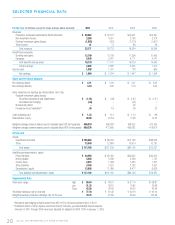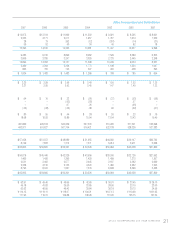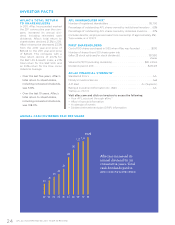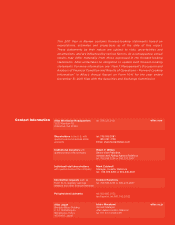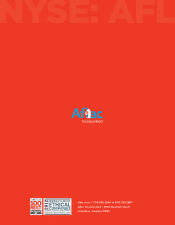Aflac 2011 Annual Report Download - page 30
Download and view the complete annual report
Please find page 30 of the 2011 Aflac annual report below. You can navigate through the pages in the report by either clicking on the pages listed below, or by using the keyword search tool below to find specific information within the annual report.
28 AFLAC INCORPORATED 2011 YEAR IN REVIEW
GLOSSARY OF SELECTED TERMS
© 2012 Aflac Incorporated. All rights reserved.
Aflac®, SmartApp®, SNG® and aflinc® are registered trademarks of American Family Life Assurance
Company of Columbus.
Communicorp, Aflac’s printing and communications subsidiary,
has received Forest Stewardship Council (FSC) certification. This
chain-of-custody certification is part of a not-for-profit organization
program that brings people together to find solutions and reward
good forest management.
Aliated Corporate Agency – Agency in Japan directly
aliated with a specific corporation that sells insurance
policies primarily to its employees
Benefit Ratio – Incurred claims plus the change in reserves
for future policy benefits, as a percentage of total revenues
Child Endowment Product – Insurance product tradition-
ally used in Japan providing cash to help fund higher costs
associated with a child entering high school and college in
Japan
DAYS – Revised base cancer policy from Aflac Japan’s
portfolio that enhances outpatient and anticancer
medication benefits
Derisking – A form of risk management that involves the
activity or series of activities of reducing or lowering risk
factors from a business
Earnings Per Basic Share – Net earnings divided by the
weighted-average number of shares outstanding for the
period
Earnings Per Diluted Share – Net earnings divided by the
weighted-average number of shares outstanding for the
period plus the weighted-average shares for the dilutive
eect of share-based awards outstanding
Group Insurance – Insurance issued to a group, such as
an employer or trade association, that covers employees
or association members and their dependents through
certificates of coverage
Individual Insurance – Insurance issued to an individual
with the policy designed to cover that person and his or her
dependents
In-force Policies – A count of policies that are active
contracts at the end of a period
Net Investment Income –
Interest and dividend income less
investment related expenses
New Annualized Premium Sales – Annual premiums,
on policies sold and incremental increases from policy
conversions, collected over a 12-month period, assuming
the policies remain in force
Operating Earnings Per Share – Profits per share derived
from operations before realized investment gains and losses
from securities transactions, impairments and derivative
and hedging activities, as well as nonrecurring items
Perpetual Securities – Financial instruments that have
characteristics of both stocks and bonds. These investments
are subordinate to senior bonds, but rank higher than
equities and generally rank higher than preferred stock.
A perpetual security does not have a stated maturity date,
but instead typically has what is sometimes referred to as an
economic maturity. An economic maturity is a date at which
a perpetual security is expected to be redeemed by the issuer
Persistency – Percentage of premiums remaining in force
at the end of a period, usually one year. For example, 95%
persistency would mean that 95% of the premiums in force
at the beginning of the period were still in force at the end
of the period
Premium Income – Revenues that an insurer receives as
premiums paid by its customers for insurance products
Return on Average Invested Assets – Net investment
income as a percentage of average cash and investments
at amortized cost
Risk-based Capital (RBC) Ratio – Statutory adjusted
capital divided by statutory required capital. This
insurance ratio is based on rules prescribed by the National
Association of Insurance Commissioners (NAIC) and
provides an indication of the amount of statutory capital
the insurance company maintains, relative to the inherent
risks in the insurer’s operations
Solvency Margin Ratio (SMR) – Solvency margin total
divided by one half of the risk total. This insurance ratio is
prescribed by the Japan Financial Services Agency and is
used for all life insurance companies in Japan to measure
the adequacy of the company’s ability to pay policyholder
claims in the event actual risks exceed expected levels
Split-rated Security – When one rating agency rates a
security as investment grade while another agency rates
the same security at below investment grade
Total Return to Shareholders – Appreciation of a share-
holder’s investment over a period of time, including rein-
vested cash dividends paid during that time
Voluntary Supplemental Insurance – Insurance policies
designed to provide an extra layer of financial protection. For
example, Aflac voluntary supplemental medical insurance
provides cash benefits that insureds may direct toward
medical or nonmedical expenses not covered by a major
medical plan or universal health care insurance system
WAYS – Hybrid insurance product from Aflac Japan’s
portfolio that starts out as a whole-life policy, but allows
a large portion of the life coverage to be converted to a
fixed annuity, medical coverage or nursing care benefit at a
predetermined age


